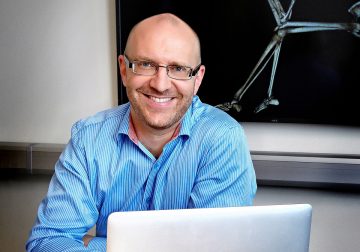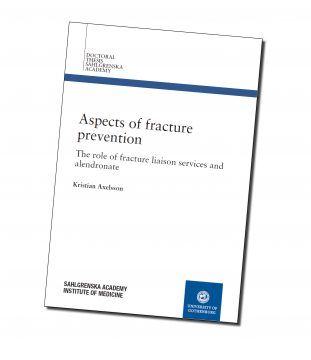
PRIZE. Kristian Axelsson’s thesis on preventing fractures has been named PhD Thesis of the Year at Sahlgrenska Academy. The thesis points out the importance of fracture liaison services, where structured and preventive work in the medical care system can greatly reduce the risk of repeated fractures among the elderly.
The “PhD Thesis of the Year at Sahlgrenska Academy” prize has been awarded since 2009 and is funded by Dr. Amt Vestby’s Research Foundation.
“It is a really great honor to receive the prize. And it is especially gratifying to know that our research on osteoporosis and fracture prevention receives such attention because this highlights the whole field,” says Kristian Axelsson.
New method in healthcare
Osteoporotic fractures generally lead to reduced mobility, poorer health and higher mortality. Patients also are four to five times more likely to suffer a new fracture up to two years after the first one.
Fracture liaison services offer a new method for the medical care system. The method involves identifying patients, assessing their risk level and investigating and treating them immediately after the first fracture. The facture coordinator overseeing the process usually works in the specialist clinics that care for fracture patients or treat the osteoporosis itself.
Noted studies
 Kristian Axelsson defended his thesis in November last year, but its sub-studies had already attracted a lot of attention in the media and elsewhere when they were published in journals. During his doctoral studies, he was a resident physician at the orthopedic clinic at Skaraborg Hospital in Skövde and responsible for the fracture liaison service in Skaraborg. Since the beginning of the year, he has served as a resident physician in general medicine at Närhälsan Norrmalm Care Center in Skövde.
Kristian Axelsson defended his thesis in November last year, but its sub-studies had already attracted a lot of attention in the media and elsewhere when they were published in journals. During his doctoral studies, he was a resident physician at the orthopedic clinic at Skaraborg Hospital in Skövde and responsible for the fracture liaison service in Skaraborg. Since the beginning of the year, he has served as a resident physician in general medicine at Närhälsan Norrmalm Care Center in Skövde.
“Since osteoporosis is mainly treated in primary care, this connection seems logical,” says Axelsson.
His thesis is currently the best evidence that fracture liaison services work. Two sub-studies base their findings on data on more than 20,000 patients from four hospitals in Region Västra Götaland and required the use of advanced statistical models.
“It was a challenge to find models to handle large amounts of data in an efficient and smart way to make optimal and innovative analyses.”
The studies show that the risk of repeated fracture was 18 percent lower after the introduction of fracture liaison services. Among the very oldest fracture patients–those over 82 years of age–only 16 needed to be screened to prevent a new fracture within five years.
Research with an impact

Mattias Lorentzon, the principal supervisor, nominated the thesis. He describes how Kristian Axelsson showed exemplary effort during his doctoral studies to spread the new knowledge he has contributed to society through informational and training events for the public, clinics, politician and patient associations and clear-cut guidelines at regional and national levels. Since last year, fracture liaison services have been given high priority in the National Board of Health and Welfare’s national guidelines. They have also been selected by the Swedish Association of Local Authorities and Regions for a person-centered and cohesive care process to be implemented in 2021. This means that the results of the thesis will soon be of great importance to many patients.
“I am most proud of the fact that the results may soon have clinical significance. This can lead to many patients receiving better care and having better health as a result.”
How are you proceeding in your research now, after your thesis?
“I have a number of different research ideas that I hope to get a chance to put into practice. Among other things, I’d like to investigate whether we can use different machine learning methods on existing registry data to estimate a patient’s fracture risk.”
Seven prize recipients
In addition to Kristian Axelsson’s thesis, which was named 2020 Thesis of the Year at Sahlgrenska Academy, a prizewinner is appointed for each of Sahlgrenska Academy’s six institutes. Due to the pandemic, there will be no award ceremony this year. In addition to the prize money, the prizewinners receive diplomas and bouquets.
Sahlgrenska Academy
Kristian Axelsson’s thesis “Aspects of fracture prevention – The role of fracture liaison services and alendronate” (Institute of Medicine)
Institute of Biomedicine
Martina Sansone’s thesis “Epidemiology of viral respiratory infections with focus on in-hospital influenza transmission”
Institute of Clinical Sciences
Nicklas Oscarsson’s thesis “Hyperbaric oxygen treatment for pelvic radiation-induced injuries. From a multicenter randomized controlled trial to an experimental cell model”
Institute of Medicine
Angela Molinaro’s thesis “Investigating the role of Class-1 Phosphoinositide 3 Kinases (PI3Ks) in insulin signaling and obesity”
Institute of Neuroscience and Physiology
Ibrahim Kaya’s thesis “Development of MALDI mass spectrometry imaging methods for probing spatial lipid biochemistry of amyloid plaques in Alzheimer’s disease”
Institute of Odontology
Lisa Svensson’s thesis “Dental anxiety: prevalence, measurements and consequences”
Institute of Health and Care Sciences
Ramona Schenell’s thesis “Maintaining self-determination in palliative phase in residential care. A model to facilitate person-centred care for older persons”
BY: ELIN LINDSTRÖM










